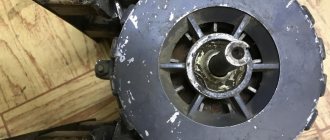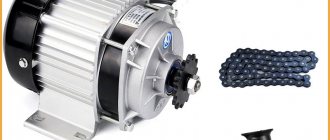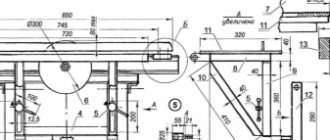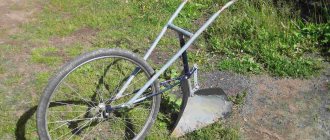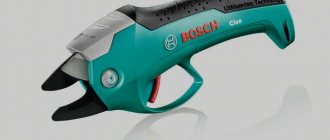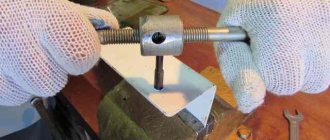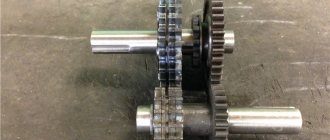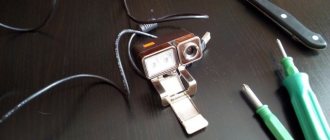Every angler who has a regular inflatable boat sooner or later thinks about installing a motor on it. Still, moving around a body of water with oars is not so easy, especially against the current. The fisherman spends a lot of physical energy that he could spend on fishing. Buying a new motor is expensive, and not everyone can afford it, but it turns out there is a way out. A boat motor can be made from cheaper components that are often found lying around in the garage or shed. In some reservoirs it is prohibited to use gasoline engines, so electric motors are used, but in other cases a gasoline engine will do.
Boat motor from a screwdriver
Screwdrivers are best for making boat motors. You should choose a device with an operating voltage of 12 V so that you can install a car battery with a capacity of 45-55 ampere-hours. The device is being finalized in an elementary way.
Cordless outboard motor based on METABO BS 18 LT 5.2 Ah screwdriver Watch this video on YouTube
Manufacturing technology
Boat motors from a trimmer are made in two ways: all parts, such as a propeller, are purchased or made by hand. The second solution will require more effort, but also less cost.
As such, the drawing is needed not for the drive itself, but for the manufacture of a homemade screw. The dimensions of the latter depend on the drive power and the weight of the boat. A propeller with parameters of 100*30 mm is quite capable of moving vehicles weighing up to 120 kg.
- It’s easier and faster to build a motor for a boat from a trimmer if you choose a model with a straight shaft. If a device with a curved shaft is used - a curved rod, it will have to be almost completely redone, since the steel cable, in principle, cannot transmit the delivery torque. In this case, you will need to make the tube yourself from duralumin, then press the bronze bushing left after disassembling the bent shaft into it, and insert a newly fitted plastic holder.
- A homemade screw is cut from a duralumin plate according to the drawing, the edges are sharpened. The blade must have a curved shape; to do this, they are bent one by one by 10 mm. The propeller can always be corrected by trimming or bending the blade more if its performance during testing turns out to be unsatisfactory.
- The screw is installed instead of the trimmer head. It is imperative to use a ring attachment, otherwise the blades may puncture or damage the boat material. The photo shows the screw fastening.
- On the Internet you can find ready-made kits for converting a lawn mower into a watercraft. It includes the drive and adapters to the shaft. The adapters are universal, which allows you to do without alterations to the curved rod and shaft. Often this kit includes a clamp. In this case, all the work comes down to assembling the modification.
- Control - starter handle, can be used from a trimmer. But if it is inconvenient, which often happens, it is replaced with any suitable switch - from a bicycle, for example.
- Homemade boat motors from a trimmer are secured with a clamp to the boat transom.
Lifting mechanism
The task of the lifting mechanism is to move the motor in various planes, both horizontal and vertical, in order not only to control the craft, but also to be able to lift the engine out of the water. The simplest design is a system of clamps with which the screwdriver is attached to the lifting mechanism. The lifting mechanism must be rigidly attached to the boat, especially if the boat is rubber. The clamps must have rings through which the tube passes, and inside the tube there is a shaft made of a steel rod of suitable diameter. To make sliding easy, bearings are installed inside the tube.
Gearbox and propeller
The screwdriver develops high speeds, but this is not necessary for a homemade electric motor for a boat, so a gearbox is needed. A gearbox from an angle grinder is the most suitable option. To attach the gearbox, the upper part of its shaft is simply clamped in the screwdriver chuck.
You will also need a propeller, which is best made of stainless steel, 2.5-3.0 mm thick. Do not use aluminum or plastic.
Procedure:
- First of all, a square blank measuring 30x30 cm is cut out.
- A square measuring 5x5 cm is marked in the center of the workpiece and diagonal lines are drawn through the corners. Along these lines you need to cut the workpiece to a small square.
- The 4 resulting petals are rounded and rotated at an angle of 30 degrees.
- In the center of the product you need to drill a hole for mounting on the gearbox.
- After this, the propeller is installed in its place and securely fastened.
Propeller for a screwdriver 2. Boat motor from a screwdriver Watch this video on YouTube
Electric motor application
This is a very interesting question. The use of conventional AC motors has been discussed for a long time. Such motors do not have a brush mechanism, so they are very easy to operate and operate.
But there are some factors that have to be taken into account. The first factor is the presence of an alternating voltage of 220 V. Alternatively, it is possible to install an inverter that can convert a direct voltage of 12 V into an alternating voltage of 220 V.
The second component is safety, because 220 V voltage is very dangerous for humans, especially on water. This requires special measures. But if there is water all around, it is difficult to even imagine what exactly these measures should consist of.
Motor made using a trimmer
Before you start making a homemade motor for a boat, you need to decide on the choice of base from which the engine and other parts important for assembly will be taken. In this case, a trimmer will be used. In addition to this option, there are many more that use everything, even an ordinary screwdriver.
However, the lawn mower wins in many respects, and the design of its engine is closest to the design of a purchased outboard motor. This is proven by the drawings that many craftsmen compared before choosing what to take as the basis for a homemade boat engine. And let's look at it like this:
- An engine that will save a huge amount of fuel (as the lawn mower is used frequently). Moreover, it can be four-stroke, just like on conventional motorboats. However, this happens very rarely and it is mostly two-stroke
- All manual gasoline mowers use a plastic and translucent tank, which allows you to constantly monitor the amount of fuel in it.
- The internal part of the design makes it possible to easily convert it to a boat motor without much strain
The main difficulty when converting a trimmer is that the mower's engine will not always be able to cope with movement through water. This is due, first of all, to the different operating technology of each engine.
On a gasoline mower, it has a high number of revolutions due to the low torque. For a boat, the exact opposite is needed. However, this is easily fixed. But for this you definitely need tools (everyone has them) and drawings.
Basic list of tools required for work:
- The trimmer itself is the basis of the future boat engine. Since most often a homemade motor is made for a rubber boat, having a small weight and size, the power of the trimmer can be small - about 0.8 kW. Even such a small power can provide an average human speed of 5-7 km per hour. However, if the motor is made for a heavier and more massive boat, you should choose mowers with higher power
- A material that is ideal for making a screw (this can be done at home), most often it is duralumin with a thickness of about 2 mm
- A vice or any other tool that allows you to secure objects (in this case, a motor to a boat)
- Metal welding machine (any, but preferably semi-automatic)
Gearbox and its influence on operation
The use of a gearbox for a boat motor allows you to change the direction of axial rotation. The gearbox changes the shaft rotation speed several times, which has a positive effect on the operating life of the engine. When equipping a gearbox with a boat motor, you should stick to the golden mean and not install a device with a large gear ratio. Failure to comply with this rule leads to excessive fuel consumption, low boat speed and engine overheating. The most reliable way to install a gearbox with the optimal gear ratio for a given engine is to test several different devices. If during operation there is no feeling of excessive load, which manifests itself in the impossibility of quickly accelerating to high speeds and the speed of the craft is quite high, then this gear ratio can be considered optimal for a given engine.
Electric motors can be used as propulsion for boats without a gearbox. The traction force of such devices is sufficient to operate stably in the mode of direct transmission of torque to the propeller. An excellent engineering solution is to use an electric motor underwater. With this arrangement, the screw is fixed directly to the motor shaft.
Making a boat motor from a chainsaw: step-by-step instructions
Let's look at the process step by step:
- we remove the chain boom, in its place we install the propeller - the cutting mechanism is removed in a few seconds;
- we are finalizing the coupling - for this a detailed drawing of the workpiece is made. We suggest using the ready-made one presented below. You can use roller bearings, as well as a shaft with a diameter of 7.8 cm;
we make grooves into which the staples will subsequently fit. To make them we need a metal corner. There is no need to take it too wide: a width of 2.5 cm is quite enough;
Using staples, we attach the components of the coupling - the cup and the upper part (lid). We secure the new structure with a screw holder. According to the drawing we proposed, the total length of the spare parts aggregated together will be 100 mm (this is the body itself, the safety shield). The height of the studs along the main axis should be 2.45 cm, and the interaxial range should be 3.2 cm. Between the shaft and the axis of the first stud in order, a larger distance will remain - 5.4 cm. To maintain these proportions, the stud must have a threaded diameter of 0.8 cm, and the thread pitch is not less than 0.1 cm;
We aggregate two working shafts - one from the gearbox, the other from the motor. To do this, take a sector-key;
- connect the gasoline engine to the shaft. A channel is useful for this; with the help of a grinder, it acquires the desired configuration;
- we drill holes with a drill to install fasteners that will prevent the structure from falling apart during operation;
attach the chainsaw - the back side of the shaft should fit onto the threads of the gearbox, which can be removed from the old grinder;
we manufacture the rotary unit in accordance with the diagram proposed below;
We attach the screw, which will create a flow of water, to the gearbox shaft - it is advisable to take a ready-made one to save time;
- fill the gearbox with transmission lubricant, secure its cover with a handy sealant;
- We install the chainsaw motor on the boat and carry out the first tests.
If desired, the structure can be additionally equipped with a throttle handle for more comfortable control or a muffler.
The resulting homemade motor will allow you to develop a power of 3.3 hp. This is enough to move through water at a speed of 10-13 km/h and consume about 750 ml of gasoline per hour of operation.
Maximum persistence with little time and material costs will allow anyone who wants to acquire a similar motor for a rubber or plastic boat, which, with reasonable operation, can last up to 6 years.
How to make a boat motor from a chainsaw with your own hands?
Having prepared all the diagrams and tools required for the work, you can proceed directly to assembling the outboard motor.
The work algorithm looks like this:
First you need to remake the factory clutch of your existing chainsaw. To do this, you will need to machine a cup of the required dimensions, and also replace the standard spring. For example, if you have a suitable metal shaft, 2 roller bearings marked 941/12, and 2 parts of type 7000 CD at hand, then a machined cup with a thickness of 16.5 and an outer diameter of 78 mm is suitable for assembling a boat motor. This cup will interact well with the roller bearings, showing stable performance with reduced friction. To attach the cup, you will need three brackets, which must be fixed in the grooves. To make staples, it is best to use a metal corner, in which one side is made in the shape of a trapezoid and is 25 mm in length. Using staples you will need to connect the coupling cover and the cup. After this, the mounting brackets must be clamped with a washer and a screw; After the completed steps, the height of the finished structure, taking into account the screen, body and distance to the base plate, should be no more than 10 cm. The distance from the first standard pin to the shaft should be equal to 5.4 cm. Since the total weight of the structure will be about 4.5 kg, then to fasten it you will need to use a pin with a metric thread applied to it with a pitch of 1 mm and a diameter of 8 mm; To mount the shaft and the motor used, you need to prepare a channel. Using a grinder, you will need to cut a piece of suitable size from it and drill a hole in it for the bolt. After this, all that remains is to connect the chainsaw to the finished structure; After this you need to make a swivel unit. For this purpose, you need to take a piece of metal pipe, the diameter of which will be several millimeters larger than the diameter of the shaft. Also, to assemble the unit you will need a pre-welded corner, a hollow metal guide with six edges, a metal blank with a rectangular cross-section and a strong metal rod of the required diameter. You will need to cut out a handle in the workpiece, the edges of which should be cleaned. Then, threads will need to be cut at the ends of the rod used, after which the entire assembly must be installed on the shaft and secured in the most convenient place for this; In the end, all that remains is to adapt the gear shaft with the screw used for assembly. If this part is not available, you will need to make it yourself. To do this, you need to cut a blank from sheet steel into which epoxy glue and fiberglass should be poured. After this, the finished screw will need to be deburred and painted.
When making a propeller for a boat motor from a chainsaw, it is very important to observe all the dimensions and proportions of its blades. Otherwise, one of the parts of the screw will be subject to increased load, which will cause the element to break very quickly.
https://youtube.com/watch?v=n1H4olf_30E
It should be noted that homemade boat motors made from chainsaws are designed to move a rubber boat with two adult passengers at a speed of no more than 20 km/h. If you regularly increase the speed, this will lead to excessive load on the chainsaw engine. It will quickly overheat and fail. As a result, the owner of the chainsaw will have to change all the seals, the cylinder-piston group of the engine, and also re-adjust the carburetor.
What is an attachment for converting a trimmer into a boat motor?
Motors for light boats are often made from trimmers.
The main ones are the following:
- A clamp for installing a homemade structure with a trimmer on a prepared boat transom has become widespread. This option is considered more affordable, but is characterized by increased efficiency in use. The special design allows the device to be used as a propeller. When performing the usual function of a motor, the mechanism is small in size, easy to install and remove, which determines its very wide distribution.
- Propeller screw. This version is a little more complicated than the previous one, but there are already ready-made mechanisms on sale that are characterized by increased efficiency in use. It is not recommended to carry out the most powerful version, since due to the resulting draft, a light PVC boat can simply capsize. Often, the delivery package includes a special drive made using corrosion-resistant steel, as well as some adapters that make the trimmer an almost universal boat motor.
- Another common option is to convert a standard mower into a motor used to create traction. In this case, it is recommended to give preference to common trimmers that require gasoline to operate. The relatively light weight of 4.5 kg is a significant advantage of this design option.
Let's celebrate! When choosing, you should take into account the operating principle of the design. The wrong trimmer will not last for a long period.
Principle of operation
When considering a trimmer, attention should be paid to the fact that such a mechanism ensures high rotation speed of the blades. This ensures a high speed of movement of the boat through the water.
The features of the operating principle include the following points:
- The blades are turned outward.
- A motor installed at the top transmits rotation to the blades.
- To increase reliability, the shaft that connects the engine to the blades is located in a protective tube.
Let's celebrate! The higher the trimmer is, the higher the speed developed. The main disadvantage of such a motor is the loud noise during operation. This factor is very important at the time of fishing, since the noise can scare away all the prey.
Benefits of using a trimmer
The trimmer has a fairly large number of advantages that determine its popularity.
Let's call the main ones:
- Relatively low cost.
- Easy to install and dismantle.
- Light weight.
- High speed achieved when moving.
- High power rating, often excessive.
- Economical.
- Initially there is a gas handle and a starter.
- There is a special leg that allows you to adjust the power of the device.
These and many other qualities determine the fairly widespread use of trimmers recently.
The most important thing is not to miss the bite!
You can end up in a “fishy” place, but not catch anything. Now there are special self-cutting fishing rods with a special mechanism:
- At the moment of a bite, the line is tensioned, which leads to the triggering of the hook.
- The fish, hooked at the right moment, remains on the hook, and all you have to do is get it out of the reservoir!
Any electric motors, whether made at home or in production, are powered by an electric motor. When creating a homemade boat motor with your own hands
, the engine can be selected from a screwdriver or a cordless drill.
Making a boat electric motor with your own hands using a drill consists of the following steps:
Advantages of an electric motor
However, a drill is not the only material from which it is possible to make a homemade electric boat motor. Electric motors are often made from screwdrivers
.
Homemade boat motor from a drill
- Availability of battery as a power source.
- A propeller with a gearbox sets the craft in motion.
- The engine controls are a reverse button and a rotation speed control knob.
But it is worth remembering that moisture penetration into the controls of an electric drill is fraught with trouble. The engine will stall and the ship will stop. The advantage is that it is very easy to find spare parts for the drill.
Another significant point is that it is not intended to operate continuously. This is not very suitable for boat engines. Therefore, it is advisable to create a power reserve to avoid overheating of the homemade product.
We recommend reading: Popular Korean manufacturers of outboard motors
- You need to start from one hundred and fifty watts and more.
- In this case, it is realistic to choose a propeller with a diameter of one hundred and thirty millimeters.
- The total weight of the vessel is no more than three hundred kilograms.
The voltage of drills and screwdrivers can be different, as well as their batteries. But the capacity of the latter is not enough to control the boat. Then a car battery that produces twelve volts will do. It is better to choose a drill with the same voltage.
Of course, a battery of batteries for any voltage will save the situation. But the cost of such a device can be expensive.
Required components
To make homemade motors for boats from a drill, you need to assemble a set of accessories and tools:
| № | Helpful information |
| 1 | slats for mounting the engine |
| 2 | when hanging on the transom, a mechanical part from an angle grinder will do |
| 3 | a pipe with a diameter of twenty millimeters is suitable for making a rod, and a frame made of a twenty by twenty millimeter profile is suitable for installing a motor |
| 4 | metal rod to create the shaft and sheet metal for the screw |
| 5 | hand scissors for tin |
| 6 | electric drill with drill bits |
| 7 | angle grinder with cutting and sharpening discs |
| 8 | self-tapping screws if there is wood in the device |
If you need to quickly remove the propeller, it is advisable to make a lifting mechanism to control the motor in a vertical and horizontal position.
To create the mechanism, you need to equip the clamps with rings and pass a tube through them. This articulated device ensures the reliability of the steering wheel.
Gearbox and propeller
The rotation speed of the drill is slightly higher than that required to operate the propeller. The gearbox will adjust the difference.
- The upper gearbox is capable of reducing speed from one and a half thousand to three hundred. In this situation, a homemade motor will allow the boat to move smoothly.
- The lower gearbox is important for horizontal positioning of the propeller. If it is taken from an angle grinder, just clamp it in the screwdriver chuck.
To make a propeller, you need to select certain sections on a steel sheet. A square of two hundred by two hundred millimeters and a thickness of three is enough. Stainless steel is much more difficult to cut, but it is preferable and lasts longer. You can also use a blade from a household exhaust fan.
You need to make holes in the center of the sheet. They are necessary for the landing screw. The slits are made diagonally, leaving a circle of thirty millimeters in the center.
The blades should be round and equal. Each one must be rotated at a certain angle and direction of rotation so that there is no vibration of the screw.
A properly assembled electric motor will return a stream of water, but without vibration. If something goes wrong, a design made for a boat with your own hands can always be improved with the help of a larger angle of inclination of the blades.
We recommend reading: Why are Tohatsu 4-stroke outboard engines so in demand?
Before you make a motor for a boat, you need to understand how it will move with its help.
It is important to take into account the weight of the vessel with all things, engine power, current strength and operating voltage. The motor power for a rubber boat or PVC should be at least twenty percent greater than the load power
This advantage will be useful in case of force majeure.
It is advisable to measure the voltage under load and during idling using a special device.
Materials and tools
When selecting equipment, you need to pay attention to two things: power and voltage. These parameters are fundamental, and the quality of operation of the finished electric motor depends on them. The power depends on the selected drill (in this case this tool is taken as the basis), so first of all you need to select this equipment.
When selecting a drill, you need to focus on its power. This figure must exceed one hundred and fifty watts. It is not worth taking a tool with lesser characteristics. In this case, the finished device will not work effectively in moving water (that is, it will not be possible to swim with such a unit on the river). It is best to use a cordless hammer drill.
The hammer drill is equipped with reverse and has several operating modes. This circumstance is important for the motor that will move the watercraft, since it will allow in the future to control the speed of the electric motor.
The second important parameter is voltage. Eighteen volt batteries should not be used. They are difficult to find and expensive. The best choice would be a drill that operates at ten or twelve volts. Such a battery is comparatively cheaper, and, most importantly, it is much easier to find on sale.
After choosing the optimal equipment, you can collect materials. To create an engine you must first acquire:
- An electric drill that will act as a motor.
- Clamps with which the drill will be attached.
- Gearbox. You can use an element from an angle grinder if you intend to install the motor on the transom of the boat.
- Round tubes with a diameter of twenty millimeters.
- Profiled pipes (20*20 millimeters).
- A round metal rod. It will be used to create an electric motor shaft.
- Sheet metal from which the screws will be made.
You will also need some tools:
- scissors for cutting metal;
- welding machine;
- Bulgarian;
- electric drill with a set of drills;
- self-tapping screws with a screwdriver if wood will be used to create the motor.
After all the elements have been collected, you can begin to create an electric boat motor with your own hands. The whole procedure consists of several stages. Work should begin by creating a lifting mechanism for the impeller. In order for the future device to work properly, it is recommended to carefully follow the instructions provided below.
What work does the manufacturer have to do?
Throughout the entire process of manufacturing a boat power unit, it is important to adhere to the correct work algorithm. First of all, the manufacturer must carefully study the detailed drawings prepared in advance
In order to prevent critical errors during design, you need to indicate in them the dimensions of all parts used, as well as the methods of their initial fastening.
The operator's subsequent sequence of actions should consist of the following steps:
- Replacing the working parts of a chainsaw with a metal pipe with a propeller;
- Installing and checking the fasteners necessary to secure the screw;
- Connecting the gearbox shaft to the power unit from a chainsaw;
- Development of the required rotary unit;
- Adaptation of the gearbox shaft used to the propeller;
- Final assembly of equipment.
The working mechanisms used for assembly will need to be prepared:
- a working and fully operational power unit from a chainsaw;
- gearbox - can be removed from an old grinder;
- propeller - you can take it ready-made or assemble it yourself;
- transom - purchased separately;
- connecting clamp.
Additionally, the manufacturer should have fasteners of various types and sizes at hand, as well as metal parts: pipes, angles, ties and spacers.
Tuning of external parts of the Urals
Here the direction of tuning depends on the style in which you want to make the motorcycle. Typically, owners choose classic custom options.
Most often, the appearance of the Urals undergoes the following changes:
- replacement of fenders, handles, mirrors, fairings, seats, footrests;
- chrome plating of parts for more shine;
- changing the shape of the fuel tank and steering wheel;
- making a new muffler.
Ural - cafe racer
One of the simplest and most popular custom styles. During the remodeling process, unnecessary parts are removed from the Urals, and old heavy ones are replaced with lightweight and stylish ones.
The tail of the motorcycle is digested to create an aerodynamic hump, and a new seat is installed. The wheels are also being updated: they should be spoked, with light rims and road tires.
Read more about how to make Cafe Racer here:
no images were found
Ural - bobber
Also quite a popular area of customization among the owners of the Urals. In this case, the rear part of the frame is modified and the rear shock absorbers are removed. The tank is replaced with a smaller version of it, and a small single seat is also made.
In principle, it’s also nothing particularly complicated, the only thing is that you’ll have to tinker with altering the motorcycle frame. And it is made of durable low-carbon steel and therefore is quite difficult to overcook.
Read more about building a Bobber with your own hands here:
no images were found
Ural - chopper
This is the most complex and expensive type of tuning of the Urals with your own hands. First, you will have to make a completely new frame. Most often, ordinary water pipes with thick walls are used for this.
You will have to tinker with finding and installing a wide rear wheel, at least 150 mm. The exhaust pipe will also need to be redesigned to make it look stylish.
The chopper driver must sit imposingly, so the footpegs will need to be moved forward, and the location of the motorcycle controls will need to be changed. And of course, make a large and wide steering wheel.
The last step will be to ensure that all parts of the motorcycle are covered with chrome and shine dazzlingly.
For an example of drawings for converting a chopper, see here:
no images were found
Assembling the sawmill
When building houses and other structures from logs, it is often necessary to cut them into beams. A chainsaw sawmill allows you to do this as efficiently as possible with good cutting accuracy. At the same time, the instrument itself does not require any modifications. It is simply fixed in a frame made, for example, from metal corners or profile pipes. The processed logs are placed on guides. The entire structure is shown in the diagram below.
In a homemade sawmill, the log is not moved: a carriage with a saw moves, fixed at the required height (depending on the thickness of the lumber) with four screws. Due to the fact that the frame moves accurately, sawing occurs carefully and the cut is smooth. The created device (a version of it is shown in the photo below) also allows you to saw boards and prepare firewood without any problems.
Jet engine design
The main elements of such a mechanism, as in the classic version, are the internal combustion engine and the propeller, only the latter is located inside a long pipe laid along the hull of the boat. Of course, “pipe” is an oversimplified term. The correct name for this part of the engine is the water conduit, and it consists of the following components:
- water intake: the front part through which water flows to the propeller;
- straightening apparatus: thanks to this element, the rotational movement of the water flow twisted by a screw is transformed into a rectilinear one;
- nozzle apparatus: the final part of the “pipe” from which water is thrown out.
Another important element of the water cannon is the reversible steering device, thanks to which the boat can change the direction of movement and also reverse.
Water jet engine design diagram
Screws (also called impellers or impellers) come in several types:
- Axial: the simplest to manufacture, but they provide the lowest efficiency and, due to the pronounced cavitation effect, can only operate at low speeds.
- Axial-diagonal: have higher efficiency and are designed for medium-speed engines;
- Diagonal and screw: the most modern and extremely difficult to manufacture varieties, they are characterized by the highest efficiency and are capable of working with high-speed engines.
Among all the components of a water cannon, propellers are in first place in terms of manufacturing complexity. For this purpose, the method of precision casting followed by grinding is used.
You should not purchase a water cannon with an impeller whose blades are welded to the hub and do not form a single whole with it: such propellers often have an imbalance, which leads to their destruction at high speeds.
Motor control and other design options for its creation
Although the electric motor is ready, it is not yet capable of cornering. In order not to turn with the help of oars, it is necessary to make minor modifications to the design. It is enough to attach a bolt to the central part of the mount, onto which you then put a pipe. This will make it possible to make turns by changing the position of the base and, accordingly, the electric motor.
You can weld another handle to the base, connecting it to a regulator responsible for supplying current to the motor. It would be advisable to use a rheostat. However, in this case, you will have to slightly change the drill itself by connecting the motor located in its body to a rheostat. This will allow you to create a more functional design.
Screwdriver as a motor
There are several ways to make an electric motor. Instead of a drill, you can use a screwdriver. In design, it is almost no different from a device with a drill. A distinctive feature of the product is its lower maintenance cost. So, one twelve-volt battery will be enough to operate the device for six hours. However, you will have to sacrifice speed due to less power.
In order for a sailing vessel to move faster, larger pitch propellers can be used. In addition, as in the previous case, the electric motor based on the screwdriver can be equipped with handles that make it easier to control.
Trimer electric motor
A trimer is also perfect for this purpose. Using this device will make the process of creating a motor much easier. The only thing the technician will need to do is shorten the length of the device and attach a screw to it. There is no need to mount the gearbox.
There is also no need to modify the control and system responsible for powering the motor. The only difficulty that may arise along the way is the problem of attaching the device to the boat. Especially for the inflatable one. But it can also be solved.
As an electric motor, you can use the units that power the windshield washers, or a simple electric motor. In the latter case, power supply difficulties may arise, since standard motors operate on an alternating voltage of two hundred and twenty volts. The problem is solved by installing an inverter.
Thus, the owner of the watercraft can create an electric motor for the boat with his own hands. You don't need any special skills for this. You just need to purchase the necessary materials and prepare some tools. It is recommended to use a drill with a power of more than one hundred and fifty watts as a motor. This indicator will allow you to move the boat both in still water and along the river. In addition to a drill, you can use a trimmer or a conventional electric motor. Another option is an electric motor based on a screwdriver. Such a device is cheaper to maintain, but problems may arise with the speed of movement of the craft.
Unlike ancient times, when you could only hope for a fair wind to appear by relying on the forces of nature, today you can move along the surface of the water in any direction without significant physical effort and in complete calm.
Thanks to scientists who obtained electricity for humanity and tamed the fire of the internal combustion engine, any boatman can independently attach some kind of motor to his watercraft.
How to make a boat motor with your own hands from a trimmer?
To assemble a motor from a trimmer to a boat, the manufacturer will need to prepare the following equipment and materials:
- household brush cutter;
- clamp. If it is not there, then you can use any other mount to securely fix the motor on the boat;
- a sheet of duralumin, the thickness of which should not be less than 2 mm;
- welding machine;
- set of fasteners;
- set of screwdrivers and wrenches.
To assemble a homemade propeller, the manufacturer will need drawings. They must indicate the exact dimensions of the blades and the method of fixing them on the axis.
It must be remembered that the lower the power of the drive used and the weight of the boat, the smaller the blades should be. For example, for a boat weighing no more than 120 kg, a propeller with 10x3 cm blades is suitable.
After preparing the equipment and carefully studying the drawings, you can begin assembling the homemade product.
The work algorithm should look like this:
- First of all, the manufacturer will need to modify the bent shaft. First you need to remove the factory nut, which is placed in a reel of pre-wound fishing line. The nut itself is shaped like a small 2-centimeter tube with an internal thread. If necessary, it can be divided into 2 small full nuts. When dismantling fasteners, you must be extremely careful not to lose them. If this happens, then it will no longer be possible to find another suitable fastener;
- After removing the nut, you will need to remove the plastic cover located on the gas button. There are no roller bearings at the end of the stock curved rod. They are replaced by an ordinary bronze bushing, which is often called a plain bearing. It must be carefully removed. Before this, you will need to unscrew the nut, and also remove the stern tube and metal shafts from the tube;
- Then you need to move on to knocking out the plastic protector located on the flexible shaft. In the future, the steel pipe can be thrown away, since it will not be possible to level it with improvised means. It can be replaced with a duralumin tube of the same diameter. You will need to install a bronze bushing into it, which will need to be moved along the canvas using a hammer. Next, you need to take a plastic protector pre-cut to the diameter and install it on the pipe;
- The next step is to make the screw. To do this, you need to cut out the duralumin blades and sharpen their edges. After this, each blade will need to be bent upward by 1 cm so that the screw pitch is at least 10 cm. You can secure the finished device using a nut;
- Next, you need to install a bicycle speed switch on the outboard motor from the brush cutter, which will replace the standard plastic cover. After this, you will need to install a muffler that will divert engine exhaust away from the boat driver;
- To secure the outboard motor from a lawn mower, you need to use two sheets of plywood. After this, it remains to clamp the shaft using 4 screws. When transporting the outboard motor from the trimmer, the shaft can be removed.
After the homemade nozzle is ready, it will need to be run in. To do this, you need to prepare a fuel mixture of fresh gasoline and motor oil in a ratio of 40:1. After this, you will need to pour the prepared mixture into the standard tank of the boat engine, start it, and let it burn out 1 full tank of fuel at idle speed. After running in, the homemade boat motor from the trimmer will be completely ready for work.
How to increase your fish catch?
Today there are many ways to increase your catch. One of the interesting options is a bite activator. It attracts fish from long distances and stimulates its appetite with the help of pheromones that are included in the composition and influence the behavior of individuals. Pheromones are natural biologically active substances that are secreted by living organisms, including fish.
Does it all really work? How not to buy a pig in a poke? Read the details in our review.
The domestic industry is already producing an outboard electric motor powered by a car battery - “Snetok”, intended for use on closed reservoirs, but amateur designers continue to develop their own engines. Moreover, in some technical and consumer qualities, these motors are superior to the industrial model - they are, as a rule, lighter, have a built-in gearbox (which increases the efficiency of the propeller), and are multi-purpose: instead of a propeller, you can install a centrifugal water pump or a cartridge from electric drills.
We bring to the attention of readers a description of the outboard electric motors of Sverdlovsk residents G. P. Kartashev and E. G. Frantsuzov.
What can a boat motor be made from?
The motor can be made in various ways, the main thing is to choose a suitable base and additional parts. An engine from a trimmer or walk-behind tractor, as well as a screwdriver, can be used as a base. A boat motor made from a chainsaw has the best characteristics.
From the trimmer
The trimmer boat motor saves fuel and has a transparent tank. The propeller (homemade propeller) is made of duralumin. The propeller blades are bent up to 10 mm, the edges are carefully sharpened. It is put on in place of the trimmer head. To prevent the propeller blades from damaging the boat during operation, use a ring attachment. The motor shaft and propeller are connected by adapters. The starter is removed from the lawnmower. The motor from the trimmer is made according to a drawing prepared in advance.
From a screwdriver
If you use a cordless screwdriver, you will get a good homemade engine. For manufacturing, it is better to choose a device with a voltage of 12 V. The process of making an electric motor for a boat with your own hands using a screwdriver:
- The propeller must have a lifting mechanism, so it is attached to the engine transom and secured with frames and plates.
- Clamps are equipped with rings. A tube with a shaft is laid through them. The shaft is made of steel wire or rod.
- Bearings are pressed inside the tube. They will provide the steel shaft with easy sliding.
- To reduce the speed of the electric motor, install a gearbox from an angle grinder. The upper part of the shaft is clamped in the screwdriver chuck.
- The propeller is made of stainless steel, the thickness of the sheet is 2.5-3 mm.
From a walk-behind tractor
From a walk-behind tractor starter you can make a motor for an engine. To assemble a four-stroke model, a simple fuel system is used, but the water pump must be of high quality. The sternwood is removed from the old boat engine. The fuel pump is installed above the carburetor so that it does not come into contact with the rocker arm, and secured with clamps. The crankshaft is mounted above the top gear. A water pump is installed under the deadwood. If you install springs, the lower rod will work freely.
You will find many other interesting homemade products from scrap materials here.
Manufacturing process
Creating a boat engine based on the above materials can proceed in different ways. Either all the main components that must be present are purchased, or they are made on their own (not difficult) using scrap materials
Calculations must be made, which then need to be used to draw a drawing of the screw. It is made based on many parameters, the main ones being the size and weight of the boat.
It is easier and better to make a motor if you choose a lawn mower model that has a straight shaft. Otherwise, it will take a lot of effort and expense to convert a curved barbell into a straight one.
If the screw is made by hand based on calculations and drawings, then the edges must be sharpened well (almost to an acute angle). The propeller blades are usually made curved by approximately 10 mm. Since the material used is the same duralumin, in case of poor screw performance, you can easily bend it, since the material is very elastic.
The screw is placed in place of the trimmer head, which is removed when disassembling the mower. It is imperative to use a nozzle in the form of a ring, since it is possible that the blades at high speeds can damage or even tear the material of the boat (if it is rubber). Adapters that allow you to connect the main motor shaft to the propeller can be purchased on the Internet. They are very cheap.
A rope starter can also be used from a lawn mower. However, if they are uncomfortable to start, you can use a speed starter from an old bicycle. After all the assembly, it is enough to secure the resulting structure onto the boat itself with a clamp.
What is an electric motor for a boat?
As the name suggests, unlike a fuel-powered boat motor, an electric motor runs on energy transferred to it from a power source. A rechargeable battery (AB) is used as such a source, so the second name for an electric motor is a rechargeable boat motor. At the same time, manufacturers produce equipment compatible with voltages of 12, 24 and 36 V, respectively, the higher this indicator, the greater the performance of the engine.
The design of electric boat motors is quite simple. The device is equipped with a control panel, tiller, connecting rod, motor, propeller and rotor. In this case, the structure is essentially divided into 2 parts: surface (tiller, control panel) and underwater (engine, propeller, rotor). And they are connected by a rod, the length of which is freely adjustable, which gives great advantages when moving and fishing in shallow water. Such a rod is made of impact-resistant metals, so that it is not afraid of collisions between the vessel and any obstacles.
The electric boat motor starts working immediately after pressing the switch once. Thus, the time required to start fuel units is significantly saved. Typically, an electric motor for boats has 4-5 speeds for forward movement and another 3 gears for reverse. In this case, the speeds are switched manually or in foot mode. This is an important factor, because, for example, fishermen need both free hands and full control of the vessel.
Thus, the design of electric motors gives them a number of advantages over fuel-powered devices. For example, an electric motor for an inflatable boat allows the vessel to move smoothly on bodies of water without scaring away the fish with the noisy operation of the engine. The same applies to plastic boats, rubber boats and other small vessels. In general, watercraft equipped with an outboard electric motor are used for:
- trolling;
- boat trips;
- spinning fishing;
- moving through bodies of water overgrown with vegetation;
- steering and maneuverability in shallow water.
Such motors also perform well in terms of power characteristics. However, they are somewhat specific, so we will consider the speed indicators of electric motors separately.
Thrust and speed of a boat with an electric motor
Unlike fuel units, the power of electric motors on a boat is measured not in horsepower and kilowatts, but using a special characteristic - thrust. The term “thrust” refers to the maximum force that a given electric outboard motor is capable of developing during operation. Moreover, the size and rotation speed of the engine propeller, which does the main work, are of decisive importance here.
Thrust is measured based on calculations of the vessel's speed and water or wind resistance and is most often expressed in pounds (to convert to kg, multiply the pound indicator by 0.45). At the same time, the displacement and dimensions of the boat are directly related to the tractive effort. The more massive the craft, the more thrust the motor should have. Moreover, for calculations the max. boat weight, i.e. weight of the vessel + equipment + cargo + passengers.
But then a treacherous question arises for shipowners: if you put a powerful electric motor for a yacht on a small boat, will its speed increase? Unfortunately, savvy fans of high-speed travel will have to be disappointed: an increase in traction is by no means equivalent to an increase in speed. The thing is that a boat with an electric motor is partially submerged and kept afloat by the force of Archimedes. And according to the laws of physics, it is virtually impossible to develop high speed overcoming such dense water resistance. So the vessel will definitely not move above the initial speed of 7-15 km/h (depending on the dimensions).
Features and benefits of the device
The name “electric motor” contains the essence of the device it denotes. An electric motor for boats means a unit that drives a boat due to the movement of the blades. Its action is based on physical laws. A special feature of electric motors is the resource they consume to perform their functions.
Today, fuel-powered boat engines are common throughout the world. An electric motor for a boat, unlike similar units, operates by consuming electricity rather than gasoline. There is a widespread belief among some boat owners that such devices are ineffective. However, it is wrong. When properly designed, an electric motor can provide sufficient traction to propel a boat through the water at normal speed.
In addition, a homemade engine has a number of advantages, for example:
- The final costs of creating such a device will be significantly lower than the market value of factory gasoline engines and electric motors.
- The country's environmental legislation strictly regulates the use of electric motors for boats. These rules do not apply to homemade units.
- The device operates with virtually no noise. This feature will be especially useful for fishermen, because any loud sounds can scare off a potential catch.
- Electricity is cheaper than fuel materials. In addition, devices equipped with internal combustion engines consume incomparably more resources than homemade electric motors.
- The boat owner has the opportunity to independently select the power of the unit that is suitable for him. The basis of a homemade motor is a drill or other devices. The characteristics of the future engine depend on their power. Which device the master chooses, these will be the performance of the electric motor.
Creating a homemade electric motor is quite simple. It is enough to strictly follow the instructions. However, you will need certain materials and tools. There shouldn't be any problems accessing them. Most of the necessary tools are already available to any owner. All materials can be found freely available in retail outlets. It is easy to find the drawings necessary for the work.
